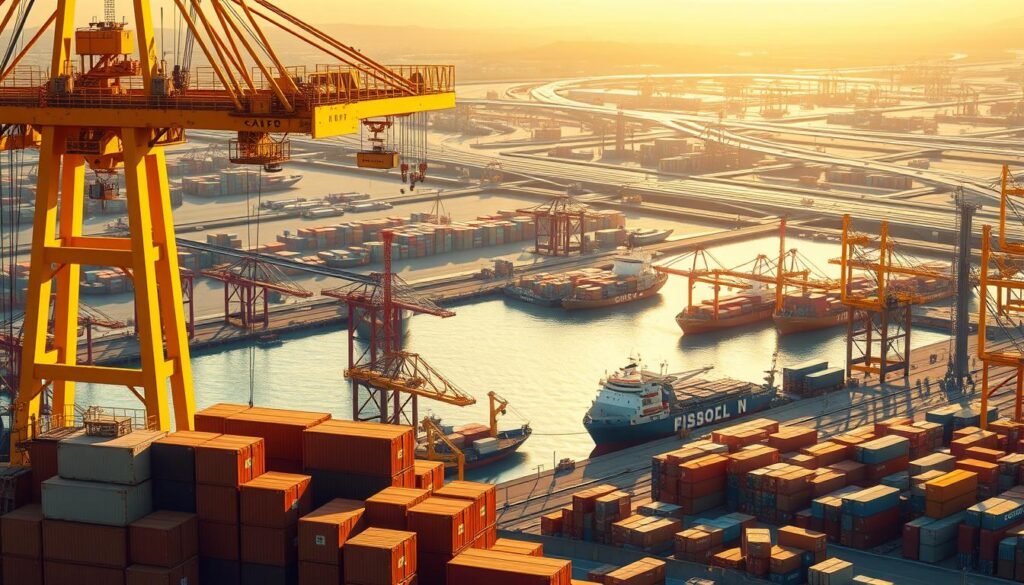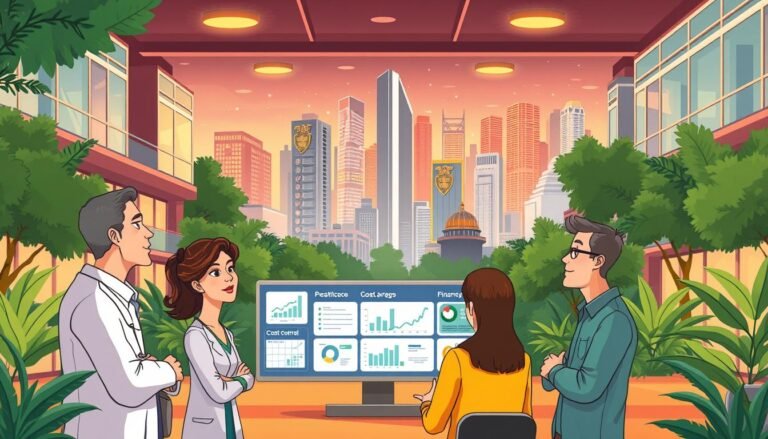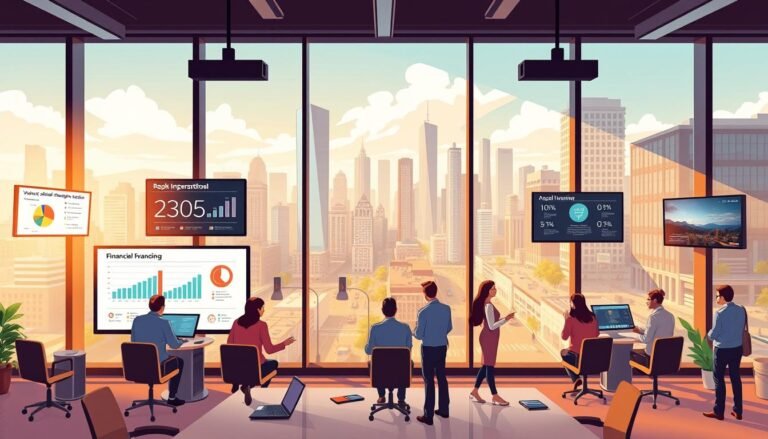Investing in port infrastructure
Could investing in port infrastructure slash shipping delays and boost U.S. trade by billions? Ports handle nearly 80% of global goods. Yet, the average ship waits 39 hours to dock, costing carriers $18,000 daily. Long Beach and Los Angeles handle 40% of U.S. imports, causing delays that affect the whole economy.
The “America’s Green Gateway” project aims to triple cargo capacity at Long Beach. It will connect to 30 rail hubs and reduce congestion. But, why do only 15 of 51 U.S. ports see clear financial wins from expansion?
Port infrastructure investment is more than just bigger terminals. Faster turnarounds could lower inflation by streamlining delivery. New ships carry triple the cargo of a decade ago, yet many ports struggle to handle them.
As trade volumes rise, so do opportunities—but risks remain. Discover how strategic port infrastructure investment could unlock $2.89 trillion in GDP and 21 million jobs while balancing environmental goals.
Key Takeaways
- Expanding one port berth boosts trade by 42% but may reduce nearby ports’ efficiency.
- Ports handling 24,000-TEU ships need deeper channels and upgraded rail links.
- $1.5 billion projects like Long Beach’s Green Gateway aim to move five million containers yearly.
- 42% trade growth from expanded capacity contrasts with 25% of ports still unprofitable despite rising volatility.
- Reducing port waiting time by one day saves carriers $18,000 per ship.
Understanding the Importance of Port Infrastructure
Ports are key players in the global economy, driving trade and boosting local economies. In 2023, U.S. ports handled $2.1 trillion in international trade, making up 41.5% of the country’s total trade. These centers support over 21.8 million jobs, from shipping to manufacturing. This shows the
The Role of Ports in Global Trade
Ports serve as gateways for goods, connecting markets around the world. In 2022, U.S. ports processed 40.1 million TEUs of cargo. Modern facilities help reduce delays, lower costs, and increase efficiency.
The Port of Los Angeles and Long Beach handle nearly 40% of U.S. container traffic. This highlights their importance in keeping supply chains strong.
Economic Multiplier Effects of Port Development
Every $1 billion invested in port upgrades creates 15,000+ jobs and $2.5 billion in economic activity. The Port of Houston’s $750 million investment supports 300,000+ Texas jobs. The Port of Virginia aims for 100% clean energy by 2040, boosting jobs and the environment.
This investing in port infrastructure benefits local businesses and workers greatly.
| Port | Project | Investment | Impact |
|---|---|---|---|
| Los Angeles | Freight efficiency upgrades | $2 billion (10-year plan) | Decarbonization and cargo speed improvements |
| Long Beach | Offshore wind facility | $170 million | Renewable energy and emissions reduction |
| Virginia | Channel deepening | $163 billion (2025 plan) | Carbon neutrality and 100% clean energy |
Strategic National Importance of Maritime Facilities
Nationwide, ports are crucial for trade competitiveness and national security. The $17 billion from the IIJA ensures U.S. ports stay competitive globally. The Harbor Maintenance Trust Fund has $10 billion for dredging and safety upgrades.
Without ongoing investing in port infrastructure, U.S. trade networks could fall behind global rivals.
Current State of US Port Infrastructure
Many US ports struggle with old infrastructure. Places like PhilaPort and Honolulu Harbor have structures over a century old. These outdated piers and limited space block growth, making it hard to meet today’s cargo needs.
Yet, there’s progress. Top container ports have added STS cranes, going from 539 in 2023 to 570 in 2024. This shows they’re getting ready for bigger ships.
New port modernization initiatives are making a difference. The Bipartisan Infrastructure Law gave $17 billion, with $2.25 billion for the Port Infrastructure Development Program (PIDP). This money helped 31 projects in 15 states and a U.S. territory.
The Port of Oakland got $49.5 million to update its outer harbor. The Don Young Port of Alaska received $50 million for a new cargo terminal. These funds are crucial for growth.
The Inflation Reduction Act added $3 billion for electric equipment and over 40,000 jobs. Clean Ports is using electric and hydrogen tech to reduce emissions. These port infrastructure investment steps aim to move 2.3 billion tons of goods yearly.
Key Drivers for Investing in Port Infrastructure
Ports are key to global trade. Investing in port infrastructure is vital for growth. Modern projects like the Port of Virginia’s deepening and the Port of Savannah’s rail upgrades show how important it is.
Supply Chain Optimization
Ports need to run smoothly to save money. When they don’t, ships wait, costing a lot. For example, the Port of Camden’s $25M road upgrades reduced truck congestion, showing small investments can make a big difference.
- Port of Savannah’s Mason Terminal: 30% capacity boost, handling 2 million TEUs annually.
- Long Beach’s Pier B: Doubles rail capacity, slashing road traffic and emissions.
Environmental Considerations
Ports are focusing on being green. JAXPORT’s hybrid-electric cranes and Seattle’s Terminal 5 are examples. They aim to reduce emissions and meet global climate goals.
| Port | Initiative | Environmental Impact |
|---|---|---|
| Port of Camden | Road upgrades | Lowered emissions via faster truck access |
| Seattle/Tacoma | Terminal 5 | 3,000 metric tons of emission cuts |
| Port of Oregon | Eco-friendly pavement | Sustainable cargo storage systems |
Technological Advancements
Automation and digital tools are changing ports. Long Beach uses digital tools to improve operations. The $17B federal funding will help bring in more tech, like IoT sensors and AI.
Trade Policy Changes
Trade policies and LNG growth are changing what ports need. The Port of Corpus Christi’s channel widening shows this. APM Terminals’ acquisitions also reflect the need to meet new demands.
Types of Port Infrastructure Investments
Ports invest in various projects to improve efficiency and stay competitive. They focus on port development projects and port infrastructure expansion opportunities. These investments tackle specific challenges and boost trade capabilities.
Terminal Expansion Projects
Expanding terminals boosts cargo handling capacity. Ports buy more land or reorganize spaces to add storage and modern facilities. These upgrades increase throughput, making ports more appealing to shipping lines.
Dredging and Channel Deepening
Deeper channels let larger vessels dock safely. For example, deepening the Savannah River to 47 feet helps ports compete globally. Dredging also reduces delays, lowering costs.
Equipment Modernization
Upgrading cranes, AGVs, and electric machinery reduces labor needs and speeds up operations. Ports that automate see faster cargo handling and fewer delays.
Intermodal Connection Improvements
Strong intermodal links, like on-dock rail lines, speed up cargo movement. Ports with rail access cut transit times by 30% or more. Highway upgrades and better transfer facilities also boost efficiency.
| Investment Type | Key Focus | Example |
|---|---|---|
| Terminal Expansion | Land acquisition, storage upgrades | Port of Los Angeles yard expansions |
| Dredging | Channel depth, vessel size | Savannah River deepening to 47ft |
| Equipment | Automation, electrification | Rotterdam’s autonomous cranes |
| Intermodal | Rail access, highway links | Port of Charleston’s rail network |
Analyzing Market Opportunities in Maritime Infrastructure
Looking for the best maritime investment opportunities begins with data. Studies reveal 15 U.S. ports show profits when they expand. The Gulf Coast ports lead in making money. This info helps investors pick the most promising spots where cargo and economic growth match.
For a smart port infrastructure investment, it’s key to watch trade trends and government spending. The U.S. has set aside $17 billion for ports through the Infrastructure Act. Also, the PIDP program gave $241 million to 25 projects. These funds are for upgrades like dredging and terminal expansions, opening doors for investors.
- Track regional trade routes and cargo demand shifts.
- Identify ports with underused capacity or outdated equipment.
- Review federal grants and private funding partnerships.
| Project | Location | Investment | Completion |
|---|---|---|---|
| Bokor Multipurpose Port | Cambodia | $1.5B | Q4 2030 |
| Aracruz Terminal | Brazil | $223M | Q2 2025 |
| U.S. Gulf Coast Upgrades | Multiple states | $17B (Infrastructure Act) | Ongoing |
New trends like LNG shipping and tech like IoT sensors are creating chances. Ports using AI for traffic management move cargo faster. Companies like APM Terminals and Adani Ports are expanding tech facilities. By following these trends, investors can make money and help global trade grow.
Port Infrastructure Financing Models
Modern port infrastructure financing uses many strategies. The Infrastructure Investment and Jobs Act (IIJA) has increased federal support. Now, the Port Infrastructure Development Program (PIDP) gives out $450 million each year, almost double before 2021.
Looking into these options helps balance costs, risks, and future gains.
Public-Private Partnerships (P3s)
P3s combine public goals with private efficiency. Build-Operate-Transfer (BOT) agreements let private companies fund construction. They get to run the operation.
Gulf Coast ports have used these models to improve terminals. They share maintenance risks with investors. This way of investing in port infrastructure often includes revenue-sharing or lease agreements.
Government Bonds and Grants
Federal grants like the PIDP offer important initial funding. Ports use these grants with municipal bonds for dredging or widening channels. State programs, like California’s Harbor Improvement Fund, use tax-exempt bonds to attract investors.
Private Equity Investment
Private equity firms now see ports as stable investments. Pension funds and sovereign wealth funds invest in terminal expansions. They often partner with shipping lines.
Phased development lets capital be used as demand grows. This reduces the risk of overcapacity.
International Development Funding
Global lenders like the World Bank finance green projects. These loans target ports in growing trade areas. They offer low-interest terms and require climate resilience.
The Asian Infrastructure Investment Bank (AIIB) has supported green energy upgrades at East Coast terminals.
Risk Assessment for Port Development Projects
Risk assessment is key for port development projects to keep port infrastructure investment on track. Changes in politics, natural disasters, and delays can throw off plans. A 2023 study found that 68% of problems at Piraeus and Thessaloniki container terminals come from unexpected issues like equipment failures or labor disputes.
- Geopolitical risks: Trade policy changes or sanctions can alter shipping routes overnight
- Natural hazards: Coastal ports face rising sea levels and extreme weather events
- Construction risks: Marine “wet works” like breakwater installations often exceed budget estimates
- Operational risks: Cargo handling disruptions cost terminals $2M-$5M daily during strikes
| Risk Category | Key Factors | Mitigation Strategies |
|---|---|---|
| Geopolitical | Trade sanctions, regulatory shifts | Scenario planning, diversified supply chains |
| Environmental | Climate change, pollution incidents | Green infrastructure, insurance coverage |
| Operational | Machinery failures, labor disputes | Redundant systems, union collaboration |
| Financial | Currency fluctuations, cost overruns | Hedging strategies, contingency funds |
Using the IMO’s PRM methodology helps measure risks like vessel collisions or cargo mishandling. This method uses HAZOP and SWIFT analysis to spot 15+ risk types that affect terminal efficiency. By tackling these issues early, investors can turn risks into chances for growth. Studies show that welfare gains can double when volatility increases, leading to stronger port infrastructure investment opportunities.
Regulatory Considerations and Compliance
Understanding regulations is key for port infrastructure investment. Laws at different levels guide port development projects. Following these rules keeps projects on track and safe for the environment.

Environmental Impact Assessments
Projects face strict reviews under laws like the National Environmental Policy Act (NEPA) and Clean Water Act. They check how projects affect habitats, water, and air. Rules from the IMO and ILO also play a role in making projects sustainable.
- NEPA requires detailed environmental reviews for federal projects.
- Clean Water Act mandates permits for dredging and construction near waterways.
- ISO standards help align with global environmental management systems.
Maritime Security Requirements
The SAFE Port Act of 2006 made it mandatory for U.S. ports to use radiation portal monitors. These tools check containers for dangerous materials, keeping workers and communities safe. Now, ports also focus on cybersecurity to protect against digital threats.
Labor Regulations
Ports must follow ILO rules on worker safety and fair pay. Training for crane operators and dockworkers is crucial for federal labor law compliance. The STCW Convention sets global standards for maritime staff.
Being proactive in following rules can save time and money. Ports in Sri Lanka, for example, faced delays due to missing permits. Working with legal experts early can help projects run smoothly.
Project Management Essentials for Port Development
Effective project management keeps port development projects on schedule. It prevents delays and cost overruns, meeting long-term goals. Successful port modernization initiatives need clear plans for each step, from design to operation.
| Key Element | Description |
|---|---|
| Comprehensive Planning | Includes traffic forecasts, economic impact analysis, and technical assessments for port development projects. |
| Stakeholder Engagement | Involves collaboration with communities, agencies, and users to secure support for modernization initiatives. |
| Governance Systems | Uses oversight committees and reporting to ensure accountability in project execution. |
| Asset Tracking | Monitors infrastructure condition to prioritize maintenance and extend asset life. |
| Construction Oversight | Manages marine challenges, phased work, and environmental safeguards during construction. |
Training staff in automation tools like AI and digital systems is key. It helps teams manage advanced technologies. Proactive asset management prevents unexpected failures, saving money in the long run. By balancing technical, environmental, and community needs, these practices make ambitious projects successful.
Technology Integration in Modern Port Facilities
Advanced technology is changing how ports work. It’s driving port modernization initiatives and opening up new maritime investment opportunities. With automated systems and data tools, ports are getting faster and safer.
Automation and Robotics
Ports are using automated cranes and automated guided vehicles (AGVs) to move containers. The Ports of Los Angeles and Long Beach have smart queuing systems. These systems cut emissions and delays.
Automation might raise labor concerns, but it reduces errors and boosts productivity.
Digital Twins and Simulation
Digital twins are virtual copies of port layouts. These 3D models let managers test scenarios without disrupting real operations. Training crews with VR tools reduces risks and speeds up adaptation.
IoT and Smart Port Solutions
- IOT sensors track containers in real time, improving inventory accuracy.
- Blockchain secures transactions, reducing paperwork and fraud risks.
- Cybersecurity measures, as outlined by ENISA and IMO guidelines, protect systems from breaches that could halt operations.
Investing in these systems requires balancing innovation with safeguards. Ports adopting these tools see faster cargo handling and better client service. This attracts investors seeking long-term gains.
Sustainable Port Development Strategies
Ports around the world are working on sustainable port development and port modernization initiatives. They aim to meet environmental goals and support economic growth. These efforts focus on energy use, emissions, and community needs.
Green Energy Implementation
Top ports are turning to renewable energy to cut down on fossil fuel use. Here are some examples:
- Shore power systems at the Ports of Los Angeles and Long Beach reduce emissions by using land-based grids to power ships.
- Pier Wind project in Long Beach aims to build offshore wind turbines, increasing clean energy production.
- On-site solar and wind installations provide clean energy for port operations.
Carbon Footprint Reduction
Modernization aims to lower emissions through:
- Switching to electric cranes and forklifts instead of diesel ones.
- The Port of Rotterdam uses renewable energy, carbon capture tech, and energy-efficient designs to cut emissions by 40% by 2025.
- The Thames Green Scheme rewards ships with low emissions with discounted fees, aiming for 60% less carbon by 2025.
Community Impact Considerations
Modern ports now focus on improving local quality of life:
- Quiet zones and noise barriers help reduce disruptions for nearby residents.
- Public parks and green spaces replace old facilities, making community access better.
- Light pollution controls and cleaner air initiatives meet local environmental goals.
These efforts make ports leaders in eco-friendly practices and operational success.
Measuring ROI on Port Infrastructure Investments
Figuring out the economic impact of port investments means looking at money made and benefits to the community. Ports make money from terminal leases and fees. But, their real worth is in helping the area grow and easing trade delays.
| Metric | Definition |
|---|---|
| Payback Period | Time to recover initial costs |
| IRR | Internal rate of return for profitability |
| NPV | Net present value of future cash flows |
| Investment Cover Ratio | Ratio of discounted cash inflows to initial investment |
Studies show port infrastructure investment brings real benefits: adding one ship boosts trade by 42% and cuts delays by 4%. Carriers pay up to $45,000 to skip a day of waiting. The Port of Lagos saw a 34% ROI boost, adding $340M a year.
- Improving efficiency cuts costs by up to 30%
- More capacity attracts new shipping and cargo
- Less congestion means a more reliable supply chain
There are also non-monetary gains like better jobs, more taxes, and less pollution. Mixing financial numbers like WACC and CAPM with these benefits leads to lasting growth. Ports with 15-20% efficiency gaps can gain millions with smart upgrades.
Case Studies: Successful Port Infrastructure Projects
Real-world examples show how investing in port infrastructure boosts the economy. These case studies give us insights into making the most of our investments and facing challenges head-on.
Port of Los Angeles Expansion
The Port of Los Angeles expanded Terminal 42 by 3.4 million sq. ft. This added 20% to cargo handling. The project used port infrastructure expansion opportunities to improve supply chains during tough times.
It introduced modern cranes and automated systems. These upgrades cut turnaround times by 15%. This shows that growing and using new technology go together.
Port of Savannah Deepening Project
The Savannah Harbor Expansion made the channel 47 ft deep. This allowed Neo-Panamax vessels to dock. The $683M project was funded partly by port development projects under PIDP’s $500M 2024 allocation.
It increased cargo capacity by 40% each year. The project was done in phases to keep operations running smoothly. It balanced environmental care with efficiency.
Port of Seattle Modernization
Seattle’s $450M Terminal 5 upgrade included IoT sensors and solar arrays. It cut emissions by 30%. This port infrastructure expansion opportunities project used $120M in federal grants.
It introduced real-time cargo tracking. This reduced truck wait times from 90 minutes to 15. It shows how smart technology can improve port operations.
These examples highlight the benefits of using federal programs like PIDP and embracing new technology. Each project focused on community involvement and growth. They offer models for future port development projects across the country.
Global Port Infrastructure Trends and Opportunities
Global port infrastructure trends are changing how we invest in maritime. Trade is growing, and we need to be green. Ports are getting bigger, using clean energy, and smart tech.
The global port infrastructure trends show a market that will grow to $315.14 billion by 2034. This growth comes from automation, going green, and smart strategies.
- Asia-Pacific is growing fast, with 15% annual investment. China’s Belt and Road Initiative is a big reason, with projects like Gwadar and Piraeus.
- Ports are turning to hydrogen, green methanol, and RNG to cut emissions. Singapore and Rotterdam are leading the way with green energy.
- Automation with AI and IoT is saving money, like at PSA Singapore’s automated terminals. It’s cutting costs by 20%.
| Region | Key Trends | Opportunities |
|---|---|---|
| Asia-Pacific | Channel deepening, LNG bunkering | Intermodal rail links, smart port tech |
| Europe | Carbon-neutral targets | Shore power systems, renewable energy grids |
| Americas | Terminal expansions | Hydrogen fuel stations, AI-driven logistics |
There are many chances to invest in maritime, like in Southeast Asia. Ports like Colombo and Jakarta are getting bigger. Companies like DP World and APM Terminals are working with governments on green projects.
Investors should look at ports connected to trade routes and those using green fuels. Places with hydrogen bunkering or solar cranes will get more money as we go greener.
Common Pitfalls to Avoid When Investing in Port Infrastructure
Investing in port infrastructure needs careful planning to avoid mistakes. Here are some common errors to watch out for:
Underestimating Development Timeframes
Projects often face delays due to long permitting, environmental reviews, and construction issues. The Long Beach International Gateway Bridge took four years to complete. The Bayonne Bridge deepening project took seven years. These delays can strain budgets and disrupt financing plans.
Overlooking Hinterland Connections
Ports need good links to rail, road, and inland networks to work well. The 2017 collapse of Baltimore’s Francis Scott Key Bridge caused weekly losses of $1.7 billion. This shows the risks of poor hinterland connections. Such failures can disrupt supply chains, raising costs for exporters and importers.
Neglecting Stakeholder Engagement
Ignoring communities, regulators, or labor groups can lead to protests or lawsuits. Recent U.S. port strikes delayed cargo for weeks, costing businesses millions. Early engagement with stakeholders can reduce delays and ensure smoother project execution.
| Pitfall | Impact | Example |
|---|---|---|
| Timeframe miscalculations | Budget overruns | Bayonne Bridge project delays |
| Poor hinterland planning | Economic losses | Baltimore bridge collapse |
| Weak stakeholder ties | Legal challenges | 2022 U.S. port labor disputes |
Proactive planning and collaboration can help avoid risks. Ports like Savannah and Los Angeles avoided issues by addressing hinterland gaps early in their expansions.
Conclusion: Building a Profitable and Sustainable Port Investment Strategy
Investing in port infrastructure needs smart planning and new ideas. Over $163 billion is set for port projects by 2025, but there’s a $38 billion gap in U.S. funding. Projects like the Port of Los Angeles’ green efforts and Rotterdam’s AI in logistics show it’s possible to be profitable and green.
Investors should focus on tech upgrades like automated terminals and digital models. These can save money and make things more efficient. For example, the Port of Shanghai and Singapore’s smart cargo systems show tech’s power. Adding green energy, like wind power and hybrid ships, meets environmental goals and saves money in the long run.
Working with the community is key to sustainable port development. Ports like Antwerp and Dubai Ports World show how to use renewable energy and reduce waste. They also focus on reducing pollution and protecting nature with special pavements and wetlands.
Success comes from mixing financial goals with caring for the planet. By using strategies from leaders and getting grants or partnerships, investors can make money and protect the environment. With the right mix of new ideas and care for the planet, port investments can grow the economy and protect nature for years.
Source Links
- Returns to Port Infrastructure Investments – https://www.nber.org/digest/202410/returns-port-infrastructure-investments
- Investing in port infrastructure can help ease inflation – https://www.krwg.org/local-viewpoints/2024-07-31/investing-in-port-infrastructure-can-help-ease-inflation
- Ports – https://infrastructurereportcard.org/cat-item/ports-infrastructure/
- The Importance of Port Investments – Land, Sea, & Air Shipping Services – InterlogUSA – https://www.interlogusa.com/answers/blog/portsfacilities-the-importance-of-port-investments/
- FACT SHEET: President Joe Biden Announces $3 Billion to Strengthen Port Infrastructure, Create Good-Paying and Union Jobs, Bring Cleaner Air to Communities | The White House – https://bidenwhitehouse.archives.gov/briefing-room/statements-releases/2024/10/29/fact-sheet-president-joe-biden-announces-3-billion-to-strengthen-port-infrastructure-create-good-paying-and-union-jobs-bring-cleaner-air-to-communities/
- Biden Administration Commits $580 Million to Strengthen U.S. Port Infrastructure – https://www.globaltrademag.com/biden-administration-commits-580-million-to-strengthen-u-s-port-infrastructure/
- Is Your 3PL Billing System Helping or Hurting Your Business? – https://www.datexcorp.com/port-infrastructure/
- Global Port Infrastructure Market Assessment, Opportunities, and Forecast, 2016-2030 – https://www.marketsandata.com/industry-reports/port-infrastructure-market
- MODULE 3 Alternative Port Management Structures and Ownership Models :: Port Finance Overview – https://www.ppiaf.org/sites/ppiaf.org/files/documents/toolkits/Portoolkit/Toolkit/module3/port_finance.html
- Chapter 11.2 – Ports and Economic Development | Port Economics, Management and Policy – https://porteconomicsmanagement.org/pemp/contents/part11/port-and-economic-development/
- Port Infrastructure Industry Research 2024-2029: Globalization Pushes Demand for Advanced Port Facilities Capable of Handling Larger Cargo Volumes – https://www.globenewswire.com/news-release/2024/10/02/2956729/28124/en/Port-Infrastructure-Industry-Research-2024-2029-Globalization-Pushes-Demand-for-Advanced-Port-Facilities-Capable-of-Handling-Larger-Cargo-Volumes.html
- Port Infrastructure Market Size, Share, Trends & Growth 2030 – https://www.alliedmarketresearch.com/port-infrastructure-market
- Chapter 4.3 – Financialization and Terminal Funding | Port Economics, Management and Policy – https://porteconomicsmanagement.org/pemp/contents/part4/financialisation-and-terminal-funding/
- PDF – https://portalcip.org/wp-content/uploads/2021/11/Port-Risk-Management-in-Containers-Petros-Pallis.pdf
- PDF – https://www.marsh.com/content/dam/marsh/Documents/PDF/US-en/ports-and-terminals-risk-challenges-solutions.pdf
- Module 6: Port Regulation Overseeing the Economic Public Interest in Ports – https://www.ppiaf.org/sites/ppiaf.org/files/documents/toolkits/Portoolkit/Toolkit/pdf/modules/06_TOOLKIT_Module6.pdf
- Chapter 11.1 – Ports, Policies, and Geopolitics | Port Economics, Management and Policy – https://porteconomicsmanagement.org/pemp/contents/part11/ports-policies-and-politics/
- Port Management Excellence – thetrainingbee.com – https://thetrainingbee.com/course/port-management-excellence/
- What Is The Concept Of Port Management? – https://www.innovez-one.com/post/what-is-the-concept-of-port-management
- Chapter 3.2 – The Digital Transformation of Ports | Port Economics, Management and Policy – https://porteconomicsmanagement.org/pemp/contents/part3/digital-transformation/
- Digitalization in ports and terminals: Technology advances bring increased risk | Marsh – https://www.marsh.com/en/industries/marine/insights/digitalization-in-ports-and-terminals-technology-advances-bring-increased-risk.html
- Ports Development Meets Environmental Sustainability | Dockmaster Blog – https://www.dockmaster.com/blog/ports-development-meets-environmental-sustainability/
- 5 examples of best practice to sustainably finance the port sector – https://www.unepfi.org/themes/ecosystems/5-examples-of-best-practice-to-sustainably-finance-the-port-sector/
- Rating Risk from the Perspective of the Concession Holder – https://www.ppiaf.org/sites/ppiaf.org/files/documents/toolkits/Portoolkit/Toolkit/module5/rating_risk.html
- Microsoft Word – 49.docx – http://wdsinet.org/Annual_Meetings/2017_Proceedings/CR PDF/cr49.pdf
- How Federal Funding is Reimagining America’s Port Infrastructure – https://tlimagazine.com/news/how-federal-funding-is-reimagining-americas-port-infrastructure/
- Successful PIDA Projects and Their Impact on Local Communities – PIDA Week 2024 – https://au-pida.org/events/a-roundup-from-digital-market-event-conference/
- Port Infrastructure Market Size, Share and Trends Report 2034 – https://www.marketresearchfuture.com/reports/port-infrastructure-market-28403
- A Strategic Race in Global Trade – Ship Universe – https://www.shipuniverse.com/news/expansion-of-port-infrastructure-investments-a-strategic-race-in-global-trade/
- 5 trends shape port infrastructure – https://www.katradis.com/port-infrastructure-development-trends/
- Several Vital Things to Consider When Planning Port Infrastructure for Efficient Logistic – Container News – https://container-news.com/several-vital-things-to-consider-when-planning-port-infrastructure-for-efficient-logistic/
- Maritime Supply Chains Face Growing Disruptions Amid Shifting Trade Policies and Infrastructure Challenges – Ship Universe – https://www.shipuniverse.com/news/maritime-supply-chains-face-growing-disruptions-amid-shifting-trade-policies-and-infrastructure-challenges/
- The impacts of port infrastructure and logistics performance on economic growth: the mediating role of seaborne trade – Journal of Shipping and Trade – https://jshippingandtrade.springeropen.com/articles/10.1186/s41072-018-0027-0
- Ports Development With Sustainability In Mind – https://www.identecsolutions.com/news/ports-development-with-sustainability-in-mind
- Understanding Port Infrastructure: Building Blocks of Global Trade – https://www.linkedin.com/pulse/understanding-port-infrastructure-building-blocks-global-pandey-f14lf








